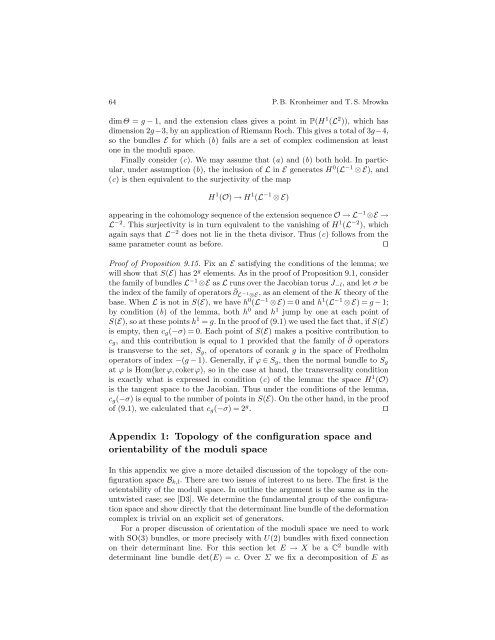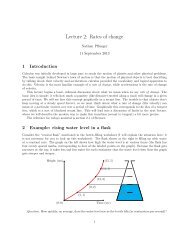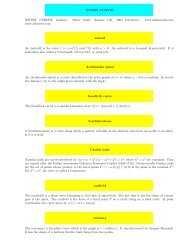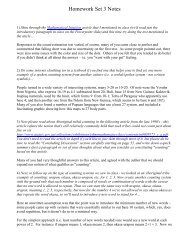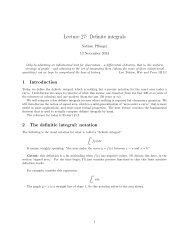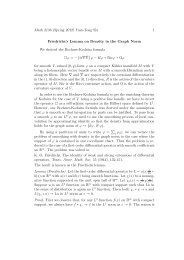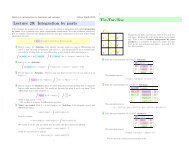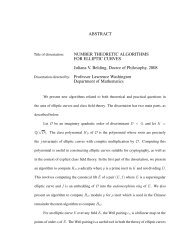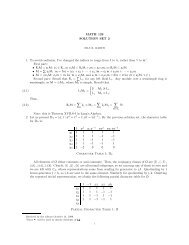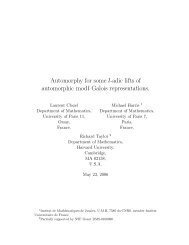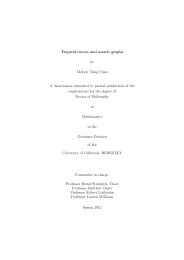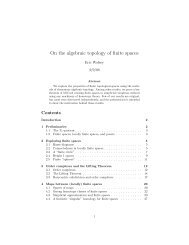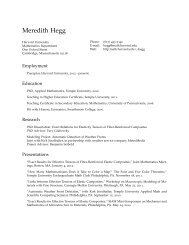Gauge theory for embedded surfaces, II
Gauge theory for embedded surfaces, II
Gauge theory for embedded surfaces, II
Create successful ePaper yourself
Turn your PDF publications into a flip-book with our unique Google optimized e-Paper software.
64 P. B. Kronheimer and T. S. Mrowka<br />
dim Θ = g − 1, and the extension class gives a point in P(H 1 (L 2 )), which has<br />
dimension 2g−3, by an application of Riemann Roch. This gives a total of 3g−4,<br />
so the bundles E <strong>for</strong> which (b) fails are a set of complex codimension at least<br />
one in the moduli space.<br />
Finally consider (c). We may assume that (a) and(b) both hold. In particular,<br />
under assumption (b), the inclusion of L in E generates H 0 (L −1 ⊗E), and<br />
(c) is then equivalent to the surjectivity of the map<br />
H 1 (O) → H 1 (L −1 ⊗E)<br />
appearing in the cohomology sequence of the extension sequence O→L −1 ⊗E →<br />
L −2 . This surjectivity is in turn equivalent to the vanishing of H 1 (L −2 ), which<br />
again says that L −2 does not lie in the theta divisor. Thus (c) follows from the<br />
same parameter count as be<strong>for</strong>e. ⊓⊔<br />
Proof of Proposition 9.15. Fix an E satisfying the conditions of the lemma; we<br />
will show that S(E) has2 g elements. As in the proof of Proposition 9.1, consider<br />
the family of bundles L −1 ⊗E as L runs over the Jacobian torus J−l, and let σ be<br />
the index of the family of operators ¯ ∂ L −1 ⊗E, asanelementoftheK<strong>theory</strong> of the<br />
base. When L is not in S(E), we have h 0 (L −1 ⊗E)=0andh 1 (L −1 ⊗E)=g−1;<br />
by condition (b) of the lemma, both h 0 and h 1 jump by one at each point of<br />
S(E), so at these points h 1 = g. In the proof of (9.1) we used the fact that, if S(E)<br />
is empty, then cg(−σ) = 0. Each point of S(E) makes a positive contribution to<br />
cg, and this contribution is equal to 1 provided that the family of ¯ ∂ operators<br />
is transverse to the set, Sg, of operators of corank g in the space of Fredholm<br />
operators of index −(g − 1). Generally, if ϕ ∈ Sg, then the normal bundle to Sg<br />
at ϕ is Hom(ker ϕ, cokerϕ), so in the case at hand, the transversality condition<br />
is exactly what is expressed in condition (c) of the lemma: the space H 1 (O)<br />
is the tangent space to the Jacobian. Thus under the conditions of the lemma,<br />
cg(−σ) is equal to the number of points in S(E). On the other hand, in the proof<br />
of (9.1), we calculated that cg(−σ)=2 g . ⊓⊔<br />
Appendix 1: Topology of the configuration space and<br />
orientability of the moduli space<br />
In this appendix we give a more detailed discussion of the topology of the configuration<br />
space Bk,l. There are two issues of interest to us here. The first is the<br />
orientability of the moduli space. In outline the argument is the same as in the<br />
untwisted case; see [D3]. We determine the fundamental group of the configuration<br />
space and show directly that the determinant line bundle of the de<strong>for</strong>mation<br />
complex is trivial on an explicit set of generators.<br />
For a proper discussion of orientation of the moduli space we need to work<br />
with SO(3) bundles, or more precisely with U(2) bundles with fixed connection<br />
on their determinant line. For this section let E → X be a C 2 bundle with<br />
determinant line bundle det(E) =c.OverΣwe fix a decomposition of E as


